
Original Link: https://www.anandtech.com/show/2339
µATX Part 2: Intel G33 Performance Review
by Gary Key on September 27, 2007 3:00 AM EST- Posted in
- Motherboards
Intel is the largest provider of graphic solutions in the PC market. Repeat that three times, and then marvel at how that can be after trying to play the latest game you or your child just brought home. Or if you're trying to play that new HD-DVD or Blu-ray title that just arrived in the mail on your Intel Integrated Graphics equipped system.
Of course, Intel is the market leader by volume rather than performance. They ship more integrated graphics chipsets than anyone else in the world. Virtually every business PC sold uses an Intel IGP, along with many of the entry level home systems where the thought of playing the latest game or watching a high definition movie on a PC is but a mere twinkle in the eye of the user. After all, there are lot more important reasons for using a PC other than for entertainment and in these markets, the Intel graphics solutions are more than sufficient.
We tend to be in with the crowd that wants more than the basic features needed for getting Windows Vista Aero certification or running Office 2007 at lightning fast speeds. While we would always buy a dedicated GPU unit for gaming, we still expect enough performance out of an IGP solution to at least play the top edutainment titles or mass market favorites like Sims 2. We also expect an IGP to provide decent video acceleration of the latest video formats when Aunt Harriet wants to view the newest sensation on YouTube or watch a home movie from last Christmas. Finally, we have been known to use HTPC boxes, and the thought of spending more for a HD decode/playback capable video card than the motherboard, CPU, and potentially memory combined is silly for such a system.
The innovation in the IGP market has been lagging for some time but has picked up in recent months with the introduction of the AMD 690G, AMD Radeon X1250, and now the NVIDIA MCP73 series. All of these solutions offer native DVI/HDMI output, HD decode and playback features, and decent enough gaming performance for those just starting or in a pinch until they can afford a better solution. Intel made some headway with the G965 chipset, and they hope to keep pace with or even surpass their competitors with the upcoming G35 chipset. Until then, we are left with a mid-year release known as the G33, aka the GMA 3100.
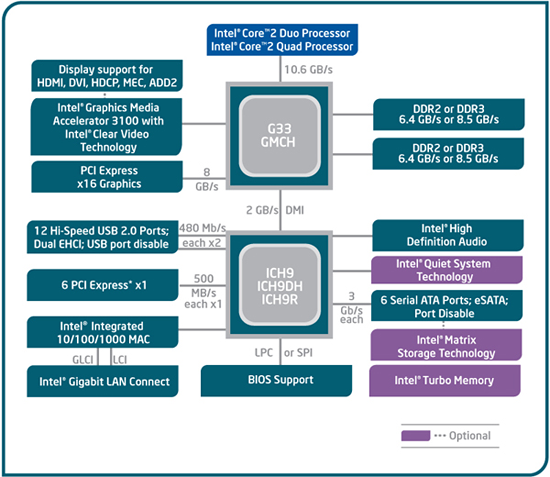
The G33 chipset is basically the P35 chipset with an integrated GMA 3100 graphics engine. As such, the chipset brings support for the 1333MHz FSB CPUs, upcoming 45nm based CPUs, and potentially DDR3. The GMA 3100 graphics engine is basically an update to the GMA 950 found in the 945G chipsets. The main highlights of the GMA 3100 are that it supports OpenGL 1.4, Shader 2.0 operations (DirectX 9.0c compliant), and Vertex Shader 2.0 is supported by software via CPU host processing. It has a 400 MHz clock, four pixel pipelines, a maximum 2048x1536 resolution, Dynamic Video Memory Technology, Clear Video processing engine, and MPEG-2 hardware decode acceleration.
Of these features, Dynamic Video Memory Technology is new and adds a twist to the UMA operations. DVMT allows the GMA 3100 to utilize anywhere from 4MB to 256MB of system memory for graphics purposes depending upon the type of application running. In 2D operation the chipset will reserve 4MB of system memory at 800x600 resolution and up to 16MB for 2048x1536 while dynamically adjusting the system memory requirements when utilizing a 3D application. HDMI, DVI, and HDCP support are provided... but only if the board manufacturer utilizes an SDVO chipset for the interface to the GMA 3100 or a separate ADD2 card is purchased. Otherwise, the user is left with the standard analog VGA output that our G33 review boards utilize today.
Even though the G33 is a "new" chipset, it still contains minimum graphics functionality and seems intent on just getting by in the market. Of course, it is not all about gaming with these platforms, but even in video playback and general application performance we see better solutions from Intel's competitors. Hopefully, this will change with the upcoming G35 chipset, but until that product actually ships we are left wanting.
Let's take a look at the G33 solutions today and see how well each board performs.
ASUS P5K-VM: Feature Set
| ASUS P5K-VM | |
| Market Segment | HTPC or SOHO - $119.99 |
| CPU Interface | Socket T (Socket 775) |
| CPU Support | LGA775-based Pentium 4, Pentium D, Core 2 Duo/Extreme/Quad |
| Chipset | Intel 8233GMH Northbridge and ICH9 Southbridge |
| Bus Speeds | Auto, 200 ~ 800 in 1MHz increments |
| Memory Ratios: DDR2 | Auto/Manual - 200FSB/667, 800; 266FSB/667, 800, 889, 1067; 333FSB/667, 800, 833, 1000, 1067, 1111, 1333 |
| PCIe Speeds | 100MHz~150MHz in 1MHz increments |
| Core Voltage | Auto, 1.1500V to 1.6000V in 0.0125V increments |
| CPU Clock Multiplier | Auto, 6x-12x in 1X increments if CPU is unlocked, downwards unlocked, Core 2 Duo |
| DRAM Voltage: DDR2 | 1.80V, 1.90V, 2.00V, 2.10V |
| DRAM Timing Control | Auto, Manual - 9 DRAM Timing Options (tCL, tRCD, tRP, tRAS, tRFC plus four) |
| DRAM Static Read Control | Auto, Enable, Disabled |
| Transaction Booster | Auto, Enable, Disabled |
| On-board Video | GMA 3100, OpenGL 1.4, Shader 2.0 (DirectX 9.0c), 400 MHz clock, Four Pixel Pipelines, Vertex Shader 2.0 supported by software via CPU processing, max 2048x1536 resolution, Dynamic Video Memory Technology, Clear Video processing engine, MPEG-2 hardware decode acceleration. |
| GFX Memory Buffer | Fixed - 128MB, 256MB, DVMT 4MB ~ 256MB |
| Memory Slots | Four 240-pin DDR2 DIMM Slots Dual-Channel Configuration Regular Unbuffered Memory to 8GB Total |
| Expansion Slots | 1 - PCIe x16 1 - PCIe x4 1 - PCI Slot 2.3 |
| Onboard SATA/RAID | 4 SATA 3Gbps Ports - ICH9 |
| Onboard IDE | 1 ATA133/100/66 Port (2 drives) - JMicron JMB368 |
| Onboard USB 2.0/IEEE-1394 | 12 USB 2.0 Ports - 6 I/O Panel - 6 via Headers Firewire 400 - VIA VT6308 - 2 ports - 1 I/O Panel, 1 via Header |
| Onboard LAN | Marvell 88E8056 - PCI Express Gigabit Ethernet controller |
| Onboard Audio | Realtek ALC883 - 8-channel HD audio codec |
| Power Connectors | ATX 24-pin, 4-pin ATX 12V |
| I/O Panel | 1 x PS/2 Keyboard 1 x D-Sub 1 x Parallel 1 x Coaxial S/PDIF out 1 x IEEE 1394 1 x Audio Panel 1 x RJ45 6 x USB 2.0/1.1 |
| Fan Headers | 3 - CPU/SYS/Chassis |
| Fan Control | CPU Fan Control via BIOS or Software, Chassis/System Fans not controlled but monitored CPU Fan Settings - Smart Fan Method - Optimal, Silent, Performance |
| BIOS Revision | 401 |
| Board Revision | v1.00 |
The ASUS P5K-VM is one of the more expensive uATX boards on the market, but ASUS has a reputation of producing some of the best motherboard. The P5K-VM comes with a good set of features, including good performance, reasonable overclocking and tweaking options, Firewire, and a fair complement of expansion options. However, there is one rather major omission with the ASUS offering: there's no DVI or HDMI port. For a modern uATX design, this is a serious oversight. We can understand skipping HDMI, because not everyone needs a motherboard that can be used for HTPC purposes, but sticking with an analog VGA connector is completely unacceptable, especially on one of the more expensive uATX boards.
Of course, this isn't really ASUS' fault, as it's a problem with the G33 chipset. In order to implement DVI support, a separate SDVO chip is required, which would simply be an extra expense. G35 should address this shortcoming, but in the meantime the latest Intel IGP solution leaves quite a bit to be desired in the graphics department.
The BIOS offers fine-grained adjustments of FSB and PCIe speeds and a limited degree of CPU multiplier tweaking. Voltage adjustments are available for the CPU and RAM, which provides a good starting point for overclocking, but the lack of chipset and bus voltage tweaking means that overclocking will be limited relative to most enthusiast motherboards. However, relative to other uATX offerings the P5K-VM does provide a decent amount of tweaking. The G33 chipset supports the latest 1333FSB Intel CPUs, and ASUS also provides unofficial DDR2-1066 support. These are all good features to have, but without a digital video connection of some form we feel a discrete GPU is almost required. In that case, why even bother with an IGP chipset? ASUS could have used a P965 or P35 chipset and improved the other aspects of the board to create a better overall package.
ASUS P5K-VM: Board Layout and Features
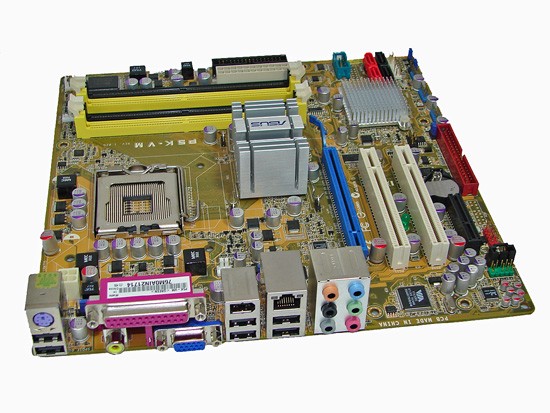
The appearance of the P5K-VM is pretty dull in comparison to other ASUS products, but its in line with their previous uATX boards. We can't say outward appearances are all that important for this market, so we'll leave it at that. Like most of their boards, ASUS now uses Conductive Polymer Aluminum Solid Capacitors on the P5K-VM. We're not sure if there's really any need for using such capacitors, given the target audience, but the board did prove to be quite stable and is one of the better uATX overclockers presently available.
The capacitor design does have the advantage of making the board very clean, and there's plenty of room around the CPU socket for a variety of cooling solutions. Whether that's even necessary for uATX boards is a question we'll leave to the philosophers. (Anyone out there planning on using a uATX board with a Tuniq 120 or Thermalright Ultra-120?)
The rear panel is somewhat interesting in that it skips the PS/2 mouse port but includes a PS/2 keyboard connection. The panel also includes a parallel port, for those still running older printers or peripherals. Six USB ports, a LAN port, a coaxial S/PDIF out port, Firewire, and six audio jack (supporting 2, 4, 6, and 8-channel audio) are available.
One of the more questionable layout decisions on the part of the ASUS is their location of the IDE port. At the very bottom edge of the board, it will be very difficult to reach this location, especially if it's used with an optical drive. Luckily, SATA optical drives are becoming increasingly common, and we would recommend users purchase an appropriate SATA optical drive if possible. A floppy connector is also present, in case anyone actually needs one.
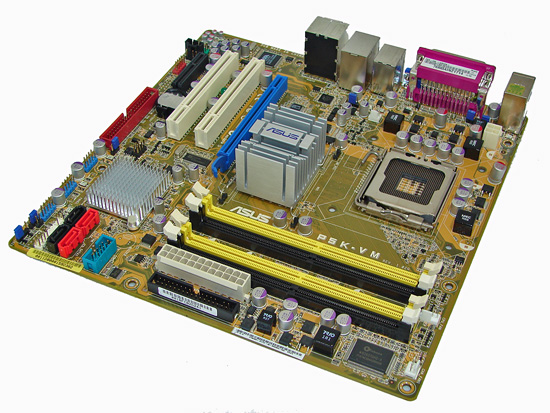 |
| Click to enlarge |
The board comes with (1) physical PCI-E x16 connector, (1) PCI-E x4 connector, and (2) PCI 2.2 slots. The first PCI slot will be blocked by a dual slot graphics card. Clearance between the DIMM socket clips and the x16 slot is also limited, requiring the removal of most longer GPUs in order to add or remove memory.
The chipsets are both passively cooled, with a large heatsink on the Northbridge. Three fan headers are available (one 4-pin and two 3-pin), which is pretty good for a uATX setup. Fan speed and monitoring control is present in the BIOS and can also be accessed by ASUS' Windows utilities.
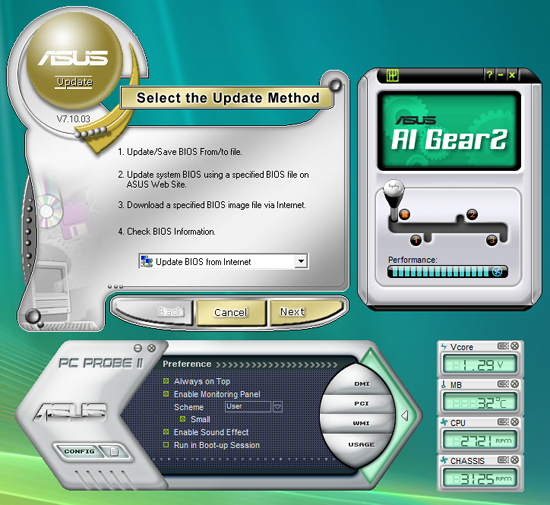
ASUS provides their usual selection of software utilities for Windows although for this board, some of the more advanced features are not available. ASUS update can be used to update the BIOS as well as other ASUS utilities. AI Gear has profiles that allow the system to dynamically controlling the FSB and CPU voltages for power saving or performance conditions, and PC Probe allows monitoring of certain voltages and temperatures. While we appreciate the utilities from all of the manufacturers and actually use some of them, sometimes they come across to us as bloatware that 90% of people won't use. Ummm... moving on....
Gigabyte GA-G33M-DS2R: Feature Set
| Gigabyte GA-G33M-DS2R | |
| Market Segment | HTPC or SFF Game - $134.99 |
| CPU Interface | Socket T (Socket 775) |
| CPU Support | LGA775-based Pentium 4, Pentium D, Core 2 Duo/Extreme/Quad |
| Chipset | Intel 8233GMH Northbridge and ICH9R Southbridge |
| Bus Speeds | Auto, 100 ~ 700 in 1MHz increments |
| Memory Ratios: DDR2 | Auto/Manual - 200FSB/3.33, 4.0; 266FSB/2.5, 3.0, 4.0; 333FSB/2.0, 2.4, 3.2 |
| PCIe Speeds | 90MHz~150MHz in 1MHz increments |
| Core Voltage | Auto, 0.50000V to 1.60000V in 0.00625V increments |
| CPU Clock Multiplier | Auto, 6x-12x in 1X increments if CPU is unlocked, downwards unlocked, Core 2 Duo |
| DRAM Voltage: DDR2 | Normal, +.1 ~ +.4V in .1V increments |
| DRAM Timing Control | Auto, Manual - 11 DRAM Timing Options (tCL, tRCD, tRP, tRAS, tRFC plus six) |
| NB Voltage | Normal, +.1 ~ +.3V in .1V increments |
| FSB Voltage | Normal, +.1 ~ +.3V in .1V increments |
| On-board Video | GMA 3100, OpenGL 1.4, Shader 2.0 (DirectX 9.0c), 400 MHz clock, Four Pixel Pipelines, Vertex Shader 2.0 supported by software via CPU processing, max 2048x1536 resolution, Dynamic Video Memory Technology, Clear Video processing engine, MPEG-2 hardware decode acceleration. |
| GFX Memory Buffer | Fixed - 128MB, 256MB, DVMT 4MB ~ 256MB |
| Memory Slots | Four 240-pin DDR2 DIMM Slots Dual-Channel Configuration Regular Unbuffered Memory to 8GB Total |
| Expansion Slots | 1 - PCIe x16 1 - PCIe x4 2 - PCI Slot 2.3 |
| Onboard SATA/RAID | 6 SATA 3Gbps Ports - ICH9R (RAID 0, 1, 5, 10) |
| Onboard IDE | 1 ATA133/100/66 Port (2 drives) - JMicron JMB361 |
| Onboard USB 2.0/IEEE-1394 | 12 USB 2.0 Ports - 4 I/O Panel - 8 via Headers Firewire 400 - T.I. TSB43AB23 - 3 ports - 1 I/O Panel, 2 via Headers |
| Onboard LAN | Realtek RTL8111B - PCI Express Gigabit Ethernet controller |
| Onboard Audio | Realtek ALC889A - 8-channel HD audio codec |
| Power Connectors | ATX 24-pin, 4-pin ATX 12V |
| I/O Panel | 1 x PS/2 Keyboard 1 x PS/2 Mouse 1 x D-Sub 1 x Parallel 1 x Serial 1 x IEEE 1394 1 x Audio Panel 1 x RJ45 4 x USB 2.0/1.1 |
| Fan Headers | 2 - CPU/SYS |
| Fan Control | CPU/SYS Fan Control via BIOS or Software CPU - Smart Fan Method - Legacy / Disable/ Intel QST; Control - Voltage or PWM |
| BIOS Revision | F5 |
| Board Revision | v1.00 |
The Gigabyte GA-G33M-DS2R is similar in many ways to the ASUS P5K-VM. It has the same expansion slot configuration, and a very similar feature set. Given the use of the same G33 chipset, that's more or less expected. Unfortunately, that means it has similar limitations -- there's no DVI or HDMI support.
The BIOS features a decent amount of overclocking and tweaking options. Voltage adjustments are a bit better than on the ASUS board, and the ability to increase the Northbridge voltage is present. However, as we'll see later, the maximum FSB overclocks we were able to attain are somewhat lower than the other two boards. There are a couple of extra memory timing adjustments available compared to the ASUS board, but the end result is much the same. Unfortunately, the price is also $15 higher than the ASUS offering, which is already expensive for a uATX board.
Gigabyte GA-G33M-DS2R: Board Layout and Features
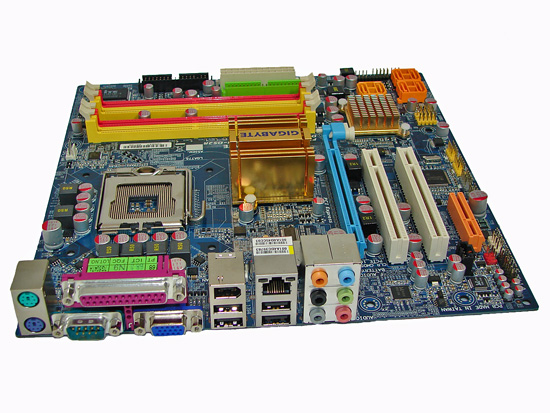
The layout and design of the Gigabyte GA-G33M-DS2R are nearly identical to the ASUS offering, with a few minor changes. First of course is that you get the technicolor appearance, which depending on your perspective is either garish, awesome, or meaningless. Gigabyte also uses Conductive Polymer Aluminum Solid Capacitors, which may account for the high price. Again, this does help to create a very clean layout with no capacitors interfering with the installation of aftermarket CPU coolers.
The rear panel of the Gigabyte board apparently caters to users that actually require legacy support, as it includes not only a parallel port but a serial port as well. We can't recall the last time we used a serial device, but of course there are other users out there that still require the interface, and it's always good to have different choices. You also get PS/2 mouse and keyboard inputs, four USB ports, a Firewire port, and six audio jacks. Gigabit Ethernet and VGA ports complete the rear panel.
Gigabyte includes six total SATA ports, as well as RAID 0/1/5 support. They also have the floppy connector in a more accessible location, although we are happy to report that the final death of the floppy drive is imminent. With support for up to 12 USB ports and three Firewire ports, we find a whopping six jumper blocks at the bottom of the board to accommodate these extra connections.
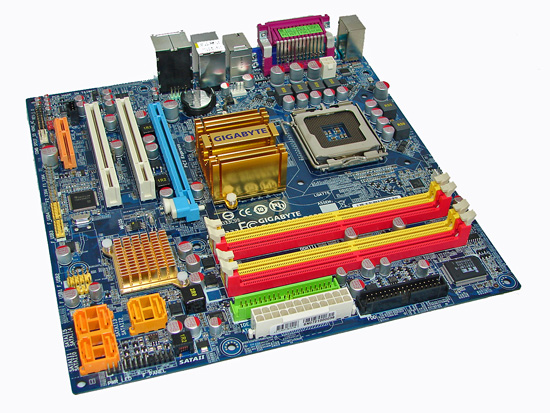 |
| Click to enlarge |
Like the ASUS motherboard, the Gigabyte board comes with (1) physical PCI-E x16 connector, (1) PCI-E x4 connector, and (2) PCI 2.2 slots. The first PCI slot will be blocked by a dual slot graphics card. Clearance between the DIMM socket clips and the x16 slot is also limited, requiring the removal of most longer GPUs in order to add or remove memory. Obviously this won't be a problem if you don't use a discrete graphics card, but without any DVI ports that may not be a safe assumption.
Again, both chipsets passively cooled, with a large heatsink on the Northbridge. Only two fan headers are available (one 4-pin and one 3-pin), which could present problems for some users. Fan speed control is present in the BIOS as well as through Gigabyte's Windows utilities.
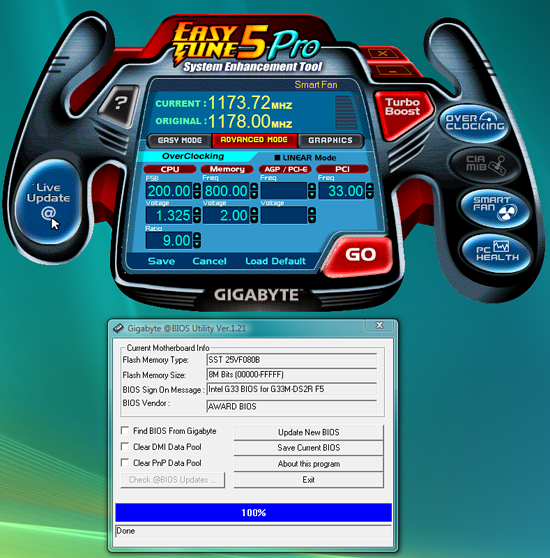
Gigabyte includes their EasyTune 5 Pro "system enhancement" utility, which provides for Windows-based overclocking, BIOS updates, temperature and fan speed monitoring, and fan controls. The utility generally works well, although we still preferred to stick with the BIOS for overclocking and avoid running any extra applications in Windows.
MSI G33M: Feature Set
| MSI G33M | |
| Market Segment | SOHO - $92.99 |
| CPU Interface | Socket T (Socket 775) |
| CPU Support | LGA775-based Pentium 4, Pentium D, Core 2 Duo/Extreme/Quad |
| Chipset | Intel 8233GMH Northbridge and ICH9 Southbridge |
| Bus Speeds | Auto, 133 ~ 800 in 1MHz increments |
| Memory Ratios: DDR2 | Auto/Manual - 200FSB/1.25, 1.150, 1.20, 2.0; 266FSB/1.25, 1.50; 333FSB/1.25, 1.50, 1.20, 1.00 |
| PCIe Speeds | 100MHz~200MHz in 1MHz increments |
| Core Voltage | Auto, 1.1500V to 1.6000V in 0.0125V increments |
| CPU Clock Multiplier | Auto, 6x-12x in 1X increments if CPU is unlocked, downwards unlocked, Core 2 Duo |
| DRAM Voltage: DDR2 | 1.80V ~ 2.60V, in .05V or .10V increments |
| DRAM Timing Control | Auto, Manual - 9 DRAM Timing Options (tCL, tRCD, tRP, tRAS, tRFC plus four) |
| NB Voltage | 1.25V ~ 1.65V, in .025V increments |
| CPU VTT Voltage | 1.20V ~ 1.60V, in .025V increments |
| SB I/O Voltage | 1.50V ~ 1.80V, in .10V increments |
| SB Core Voltage | 1.05V or 1.15V |
| On-board Video | GMA 3100, OpenGL 1.4, Shader 2.0 (DirectX 9.0c), 400 MHz clock, Four Pixel Pipelines, Vertex Shader 2.0 supported by software via CPU processing, max 2048x1536 resolution, Dynamic Video Memory Technology, Clear Video processing engine, MPEG-2 hardware decode acceleration. |
| GFX Memory Buffer | Fixed - 128MB, 256MB, DVMT 4MB ~ 256MB |
| Memory Slots | Four 240-pin DDR2 DIMM Slots Dual-Channel Configuration Regular Unbuffered Memory to 8GB Total |
| Expansion Slots | 1 - PCIe x16 1 - PCIe x1 2 - PCI Slot 2.3 |
| Onboard SATA/RAID | 4 SATA 3Gbps Ports - ICH9 (2 SATA, 2 eSATA) 1 SATA 3Gbps Port - Marvell 88SE6111 |
| Onboard IDE | 1 ATA133/100/66 Port (2 drives) - Marvell 88SE6111 |
| Onboard USB 2.0/IEEE-1394 | 12 USB 2.0 Ports - 6 I/O Panel - 6 via Headers Firewire 400 - VIA VT6308 - 2 ports - 1 I/O Panel, 1 via Header |
| Onboard LAN | Marvell 88E8056 - PCI Express Gigabit Ethernet controller |
| Onboard Audio | Realtek ALC888 - 8-channel HD audio codec |
| Power Connectors | ATX 24-pin, 4-pin ATX 12V |
| I/O Panel | 1 x PS/2 Keyboard 1 x PS/2 Mouse 1 x D-Sub 2 x eSATA 1 x IEEE 1394 1 x Audio Panel 1 x RJ45 6 x USB 2.0/1.1 |
| Fan Headers | 2 - CPU/Chassis |
| Fan Control | CPU/Chassis Fan Control via BIOS or Software CPU Fan Settings - Temperature 40C ~ 70C, Chassis Fan Setting - Duty Cycle 50%, 75%, 100% |
| BIOS Revision | 1.1 |
| Board Revision | v1.00 |
The MSI G33M is also very similar to the other G33 offerings, with the only real difference being a slight change to the expansion slot configuration and the rear panel. DVI and HDMI are of course still MIA.
The BIOS options are the best of the three G33 boards we're looking at today, at least in terms of pure tweaking options. Besides bus speed and multiplier adjustments, MSI includes the ability to tweak the voltages for the memory, CPU, Northbridge, Southbridge, and the SB I/O. The voltage granularity is also finer than on the ASUS and Gigabyte boards, allowing 0.025V adjustments on the CPU and Northbridge and 0.05V-0.1V adjustments on the memory up to 2.6V. Memory timing options include the standard tCL, tRCD, tRP, and tRAS plus an additional four options. Final overclocking results are about the same as the ASUS P5K-VM, however.
MSI G33M: Board Layout and Features
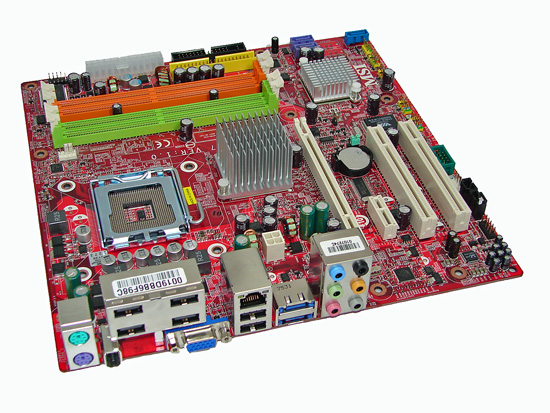
MSI includes most of the same features as Gigabyte and ASUS, but the location of some of these features is different. The color scheme is also different, coming in MSI's typical red PCB with a few colorful additions. MSI does save a bit of money by using standard electrolyte capacitors in some areas rather than 100% "solid" conductive polymer aluminum capacitors. We really don't have a problem with this approach, as none of the three boards we're looking at today really target the high-end market.
MSI's rear panel is definitely unique in terms of layout, with four of the USB ports coming on a block that sits above the VGA and Firewire ports. MSI also offers two eSATA ports, at the cost of providing two internal SATA connectors. They use a Marvell chip to power the IDE port as well as an additional SATA port. The remainder of the rear panel consists of the typical PS/2, Firewire, network, and audio connections.
The location and layout of the connectors is generally fine, but the ATX12V is located below the CPU socket, and in most cases it will require looping the cable above the CPU heatsink which is less than ideal. You can also see the blank area on the bottom of the board where two additional SATA ports could have been installed. A single eSATA port would have been sufficient, we think, but perhaps there are people out there that make more use of eSATA than us.
One final concern worth pointing out on the MSI design is that the DIMM slots are not properly color coordinated, at least not relative to the rest of the industry. We generally feel that users like to install DIMMs into the same colored slots for dual channel operation, but MSI chooses to color channel A orange and channel B green. This makes it a lot more difficult to explain which slots should be used for dual channel operation, as you actually have to use the first orange and the first green slot (or the second slots on both channels) to get dual channel memory support. It seems like it would be a lot easier to simply say "install memory into the same colored slots" -- and considering the rest of the industry has taken that approach, we feel MSI should join the club.
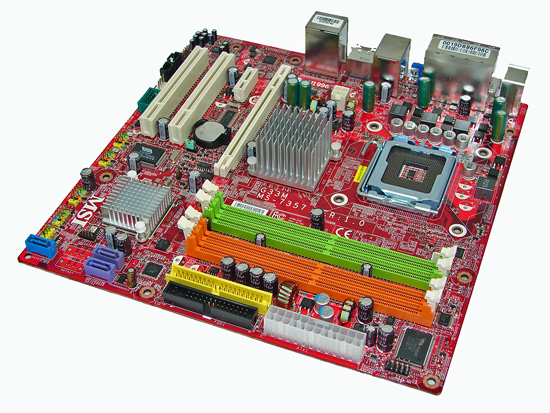 |
| Click to enlarge |
MSI chose to include a PCI-E x1 slot in place of the x4 slots on the Gigabyte and ASUS boards, and they have the slot located next to the main x16 connector. That means if users happen to install a dual slot GPU they will not have access to any other PCI-E slots. Whether or not that's a serious problem is up to the individual to decide, but PCI ports are becoming less and less used as time goes on so long term this may not be the best design decision. Clearance between the PEG slot in the memory clips continues to be very tight, and use of a smaller graphics card might be advisable on all three of these motherboards. Anyone looking at an HTPC setup would probably use one of the fanless GeForce 8500/8600 or Radeon 2400/2600 cards, but gamers might find it difficult to install a GeForce 8800 or Radeon HD 2900.
Both chipsets are passively cooled, just like the other two boards. That's a really good design decision for anyone looking at creating a silent HTPC, but then we have to return to the video output options and end up scratching our heads. If it isn't clear yet, we really aren't all that impressed with the G33 chipset. MSI also includes two fan headers, both 4-pin: one for the CPU and one for the chassis. The chassis connector is located at the very bottom, just below the last PCI slot. Fan speeds for both connectors can be individually controlled within the BIOS or via software.
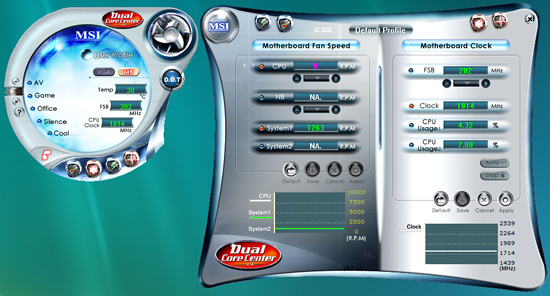
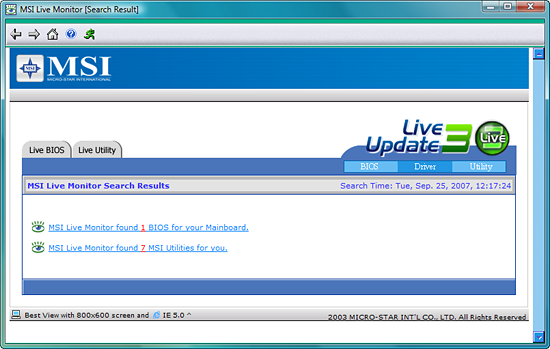
Naturally, MSI also includes a set of software utilities. Other than the MSI Live Monitor, these utilities of course have to have unique appearances with funky shaped windows and odd button locations. Call us old-fashioned, but we really don't have a problem with rectangular application windows that follow the standard Windows look and feel.
Overclocking Performance Summary
| MSI G33M / Gigabyte GA-G33M-DS2R / ASUS P5K-VM Overclocking | |
| Processor | Intel Pentium (Core 2 Based) E2160 Dual Core, 1.8GHz, 1MB Unified Cache, 9x Multiplier, 800FSB |
| CPU Voltage | Variable - 1.2750V ~ 1.4750V |
| Cooling | Scythe Ninja Mini |
| Power Supply | Seasonic S-12 II 430W |
| Memory | OCZ HPC Reaper PC2-6400 (4x1GB) |
| Memory Settings | Variable - DDR2-800 ~ DDR2-1050 |
| Video Cards | Gigabyte HD 2600XT |
| Video Drivers | AMD 7.9 |
| BIOS | MSI 1.10, Gigabyte F5, ASUS 0401 |
| Operating System | Windows Vista Home Premium 32-bit |
| . | |
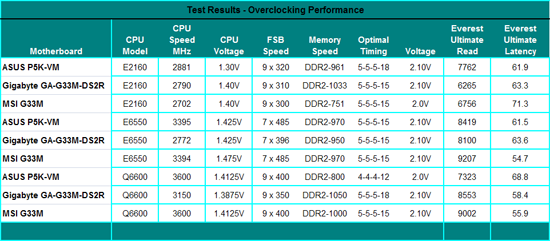 |
| Click to enlarge |
Over the next three pages we will show the overclocking details, but the general results are listed above if you want to skip ahead. The ASUS P5K-VM is the overall best overclocking G33 board and rivals several P35 boards. The MSI board overclocks very well with 1066MHz or 1333MHz FSB CPUs but has trouble with 800MHz FSB CPUs. Also, the MSI board typically needs additional CPU voltage compared to the ASUS board, but memory speeds are generally higher.
The Gigabyte board overclocks well for a typical uATX board but we had several problems with stability above 400FSB using the F5 BIOS. We had better results with the F4 BIOS in testing. The MSI and Gigabyte boards offer limited memory ratios for the 800MHz FSB CPUs which limit overclocking with them unless you purchase expensive DDR2-1066 memory. This is a real problem with us is the 3.33 or 4.0 ratio when utilizing an 800FSB CPU on the Gigabyte board. This is unacceptable for a board with a performance oriented tilt in the uATX market sector. That being said, we were able to run our OCZ HPC Reaper at significantly higher speeds on the Gigabyte board and actually broke the 1100MHz barrier, but it required 2.2V which is outside the manufacturer's limit. Although the Gigabyte board ran memory at higher overall speeds than the other two boards, it was at the expense of chipset and memory sub-timings in most instances.
ASUS P5K-VM: Overclocking
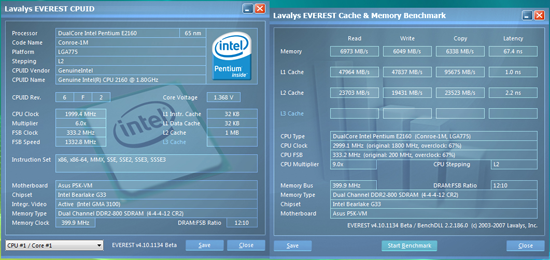 |
| Click to enlarge |
Our best results with the integrated graphics solutions was a final benchmark stable setting of 9x333 FSB resulting in a clock speed of 2999MHz. However, this required a CPU voltage setting of 1.425V, and memory remaining at DDR2-800.
 |
| Click to enlarge |
Our best results with the E2160 and with an external graphics card was a final benchmark stable setting of 9x320 FSB resulting in a clock speed of 2881MHz with a CPU voltage setting of 1.35V. We were able to run our memory at DDR2-961 with timings of 5-5-5-18 at 2.1V. This pattern was continued with the other G33 boards. Due to strap and chipset timing changes within the BIOS, we could not run our E2160 higher than a 333FSB without locking up the board. We did modify another E2160 to run natively at 1066FSB and did reach a final 9x385 FSB setting.
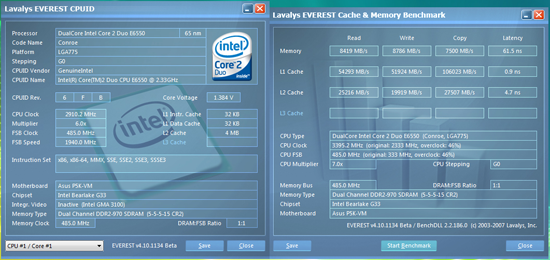 |
| Click to enlarge |
We were able to run the E6550 up to 7x485 FSB on 1.425V and memory at DDR2-970 with 2.10V. Memory timings were set to 5-5-5-15. Vdrop/Vdroop was very good on this board with an average of .02V ~.03V difference during load conditions.
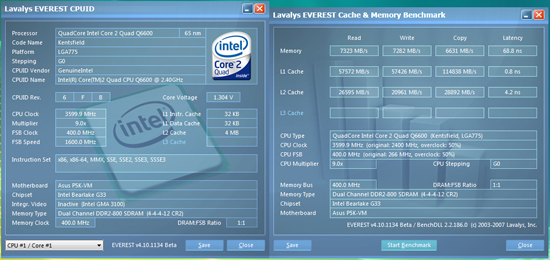 |
| Click to enlarge |
Our Q6600 was able to make it to 9x400 with voltage settings around 1.40V to 1.425V. The board would actually reach around 435FSB with this particular CPU but we were already at the limits of our cooling solution at the 9x400 setting. Memory had to remain at a 1:1 ratio resulting in DDR2-800 settings with 4-4-4-12 timings.
Gigabyte GA-G33M-DS2R: Overclocking
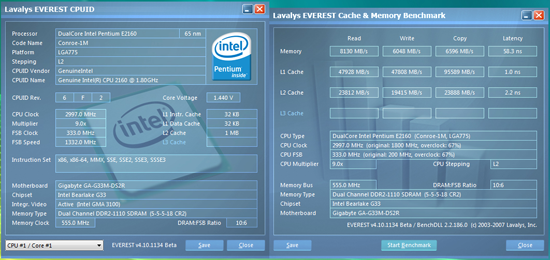 |
| Click to enlarge |
Our best results with the integrated graphics solutions was a final benchmark stable setting of 9x333 FSB resulting in a clock speed of 2997MHz. This required a CPU voltage setting of 1.450V on this board. Unlike the ASUS board, we were able to crank the memory speed up DDR2-1110 with timings at 5-5-5-18 at a voltage of 2.2 which is the absolute limit of our memory (and really a little more than we thought it would do). What did this buy us in terms of application performance improvements outside of SuperPI, Sandra, or Everest? Nothing really, as the few application benchmarks that are memory throughput sensitive only improve by a percent or so.
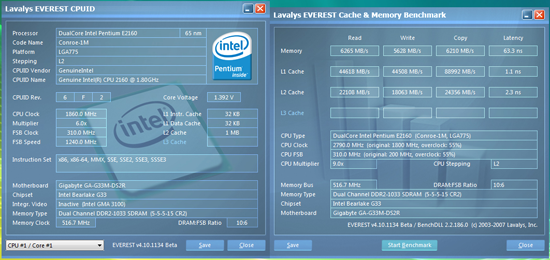 |
| Click to enlarge |
Utilizing the E2160 and external GPU we reached a final benchmark stable setting of 9x310 FSB resulting in a clock speed of 2790MHz with a CPU voltage setting of 1.425V. Memory settings were once again aggressive on this board with a DDR2-1033 speed and timings at 5-5-5-15 at 2.10V. The board was actually capable of running at 9x375 FSB with our modified E2160. Vdrop/Vdroop was acceptable with a decrease of around .02~.04V during load testing.
 |
| Click to enlarge |
The E6550 reached 7x396 at voltage settings of 1.425V which is far below the 7x485 capability of the ASUS and MSI boards. We tried other 1333MHz FSB CPUs with the same results, and any setting over 400FSB resulted in sporadic operation or no POST conditions. It appears to us that the BIOS is not properly setting the strap timings. Our memory speed was set at DDR2-950 with timings at 5-5-5-15 and 2.1V.
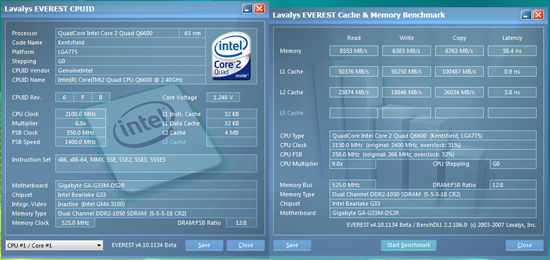 |
| Click to enlarge |
We were hoping for better results with our 1066MHz FSB based Q6600 but were met with a 9x350FSB limit at 1.3875V resulting in a CPU speed of 3150MHz. Once again, this board allowed us to run fairly highly memory speeds unlike the ASUS board, but at the expense of sub-timings. The final memory speed was DDR2-1050 at 5-5-5-18 timings.
MSI G33M: Overclocking
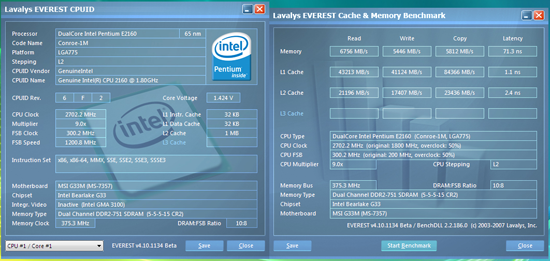 |
| Click to enlarge |
On the MSI board we ended up at a final 9x300 FSB setting for either the integrated graphics or external GPU solution with the E2160, resulting in a clock speed of 2702MHz with a CPU voltage setting of 1.425V. The board would not POST above 9x315. We could not run at memory dividers other than 1:1 with this combination either; any change would result in a no POST condition. Our final memory speed was DDR2-751 with timings at 5-5-5-15. CAS4 settings would not work when overclocking the board with the integrated graphics solution. Vdroop was decent with a loss of around .02~.03V during load testing.
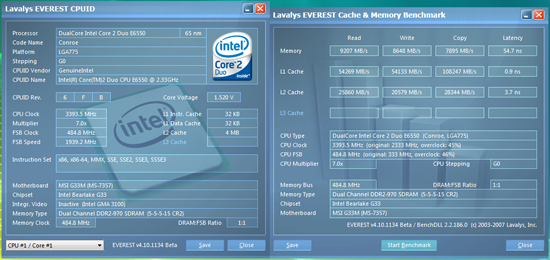 |
| Click to enlarge |
We had no issues getting our E6550 to clock up on this board and had a final setting of 7x485 resulting in a CPU speed of 3393MHz. However, the board needed an increased CPU voltage in order to reach this setting. We set the voltage to 1.475V, which with this CPU is the limit of our air cooling solution, but the board decided to increase voltage to 1.50V or sometimes to 1.525V. We decreased our voltage to 1.450 and it would generate the same behavior, although the temperatures were still in check so we stayed with this maximum setting. We ran the memory at DDR2-970 with timings at 5-5-5-15 at 2.10V.
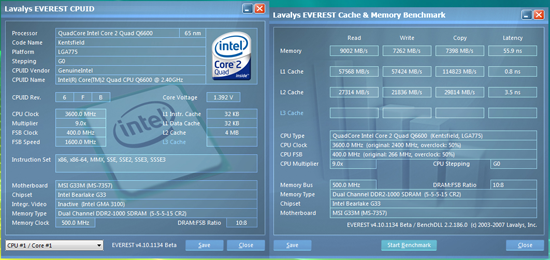 |
| Click to enlarge |
This board also had no issues with the Q6600 and we stayed at the 9x400 setting with a final CPU speed of 3600MHz at 1.425V -- slightly higher than the ASUS board. Memory was set to DDR2-1000 at 5-5-5-15 settings. This board reached 9x425 at 1.475V before we had to shut it down due to soaring temperatures.
Test Setup
| MSI G33M / Gigabyte GA-G33M-DS2R / ASUS P5K-VM Testbed | |
| Processor | Intel Pentium (Core 2 Based) E2160 Dual Core, 1.8GHz, 1MB Unified Cache, 9x Multiplier, 800FSB |
| CPU Voltage | 1.2750V |
| Cooling | Scythe Ninja Mini |
| Power Supply | Seasonic S-12 II 430W |
| Memory | OCZ HPC Reaper PC2-6400 (4x1GB) |
| Memory Settings | 4-4-4-12 (2.0V) |
| Video Cards | On-board GMA3100, Gigabyte HD 2600XT |
| Video Drivers | Intel 15.6, AMD 7.9 |
| Platform Drivers | Intel - 8.3.1.1009 |
| Hard Drive | Seagate DB35.3 7200RPM 750GB SATA 3/Gbps 16MB Buffer |
| Optical Drives | Plextor PX-B900A, Toshiba SD-H802A, Pioneer BDC-S02BK |
| Audio Card | Realtek ALC-888, ASUS Xonar D2 |
| Audio Drivers | Realtek 1.73, ASUS 5.12.01.0008.17.19 |
| Audio Test Equipment | Swans M10 (2.1), Swans D1080 (2.0), Acculine A2 (5.1) Onkyo TX-SR605 A/V Receiver |
| Case | Zalman HD160XT |
| BIOS | MSI 1.10, Gigabyte F5, ASUS 0401 |
| Operating System | Windows Vista Home Premium 32-bit |
| . | |
We selected the Intel Pentium E2160 Core 2 derived processor as our main choice for the Intel boards since it represents a great bargain when comparing price against performance in the low end of the market where we will concentrate our review efforts. We also switched to Microsoft Vista Home Premium 32-bit as our operating system of choice for this category. After speaking with several of the larger OEMs, we found out this OS choice is the one most widely offered to consumers. It was a natural then that we would test on Vista Home Premium with a 4GB memory configuration due to rapidly falling memory prices. Even though Vista 32-bit cannot take advantage of the entire 4GB of memory address space, we found the additional 1.2GB (on average) of memory available provided slightly improved performance during multitasking events and gaming with an external video card. We would not recommend anything less than 2GB with Vista Home Premium.
Our hard drive choice is a little out of the norm but since we will be testing the multimedia capabilities of our boards in the HTPC article we felt like the PVR designed drive would be a natural fit. Our OCZ memory choice was determined based upon a combination of price and performance levels that will be required during the overclocking testing with the higher end G33 boards. We did test each board with a wide variety of budget DDR2-800 memory from several suppliers that will be listed in our compatibility charts at the end of this article series. Our boards were set to utilize 256MB of memory for the IGP solution. The ASRock X1250 based board supported up to 512MB of shared memory but we left the setting at 256MB.
We will also present GPU comparison testing using external video cards from AMD and NVIDIA. Our results today will include gaming performance results with the AMD HD 2600XT from Gigabyte. All other components in our test configurations are identical with the boards being set up in their default configurations except for memory settings being optimized to ensure maximum throughput on each board. We will cover image quality analysis, audio, installation, and peripheral components in detail in separate articles.
Our choice of software applications to test is based on programs that enjoy widespread usage and produce repeatable and consistent results during testing. Microsoft Vista has thrown a monkey wrench into testing as the aggressive nature of the operating system to constantly optimize application loading and retrieval from memory or the storage system presented some interesting obstacles. This along with what we still see as a lack of driver maturity will continue to present problems in the near future with benchmark selections. Our normal process is to change our power settings to performance, delete the contents of the Prefetch folder, and then reboot after each benchmark run. A lengthy process to be sure but one that results in consistency over the course of benchmark testing. All applications are run with administer privileges.
Our MSI G33M results will be different compared to the last article. We retested the board with the latest 1.10 release that allowed us to change our memory timings from 5-5-5-15 to 4-4-4-12. Also, significant improvements were noticed in relationship to overclocking, power management, and general memory throughput.
Memory Testing
 |
| Click to enlarge |
All of the boards are able to run our 4GB of OCZ HPC Reaper at DDR2-800 speeds on 2.04V or less. Our optimal timings for each board are 4-4-4-12 at DDR2-800. The ASUS and MSI boards have the best overall memory throughput and latencies of the test boards. In the Sandra unbuffered scores the ASUS board is around 8% better than the Gigabyte board, though latencies are extremely close. In a couple of our application benchmarks that rely on memory throughput, this advantage will be apparent for the ASUS board and to a certain extent the MSI board.
 |
| Click to enlarge |
 |
| Click to enlarge |
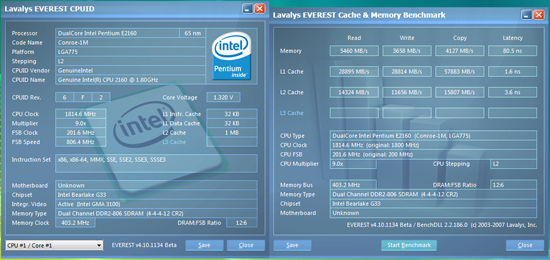 |
| Click to enlarge |
In our EVEREST benchmarks we see the same pattern as in the Sandra benchmarks. However, the MSI board scores slightly better due to a slight CPU FSB advantage at stock speeds. The MSI runs at 201.6MHz, ASUS at 200.8, and the Gigabyte board at an even 200MHz. MSI receives a flagrant foul in this case as manually setting the FSB to 200 results in the same setting. Although the difference is slight, it is just enough to place the board ahead of the ASUS in these scores.
Benchmark Suite Performance
The 3DMark series of benchmarks developed and provided by Futuremark are among the most widely used tools for benchmark reporting and comparisons. Although the benchmarks are very useful for providing apple to apple comparisons across a broad array of GPU and CPU configurations they are not a substitute for actual application and gaming benchmarks. In this sense we consider the 3DMark benchmarks to be purely synthetic in nature but still valuable for providing consistent measurements of performance.
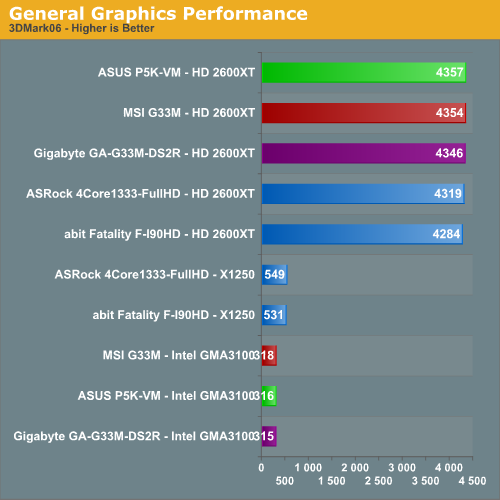
The SM2.0 performance of the X1250 is significantly better than the GMA 3100 on the G33 boards and results in the improved scores, although CPU performance helps the Intel chipset slightly. Worth noting is that neither the X1250 nor the GMA 3100 support SM3.0 graphics - unlike the GMA X3100 found in the G965.
General System Performance
The PCMark05 benchmark developed and provided by Futuremark was designed for determining overall system performance for the typical home computing user. This tool provides both system and component level benchmarking results utilizing subsets of real world applications or programs. This benchmark is useful for providing comparative results across a broad array of Graphics subsystems, CPU, Hard Disk, and Memory configurations along with multithreading results. In this sense we consider the PCMark benchmark to be both synthetic and real world in nature while providing consistency in our benchmark results.
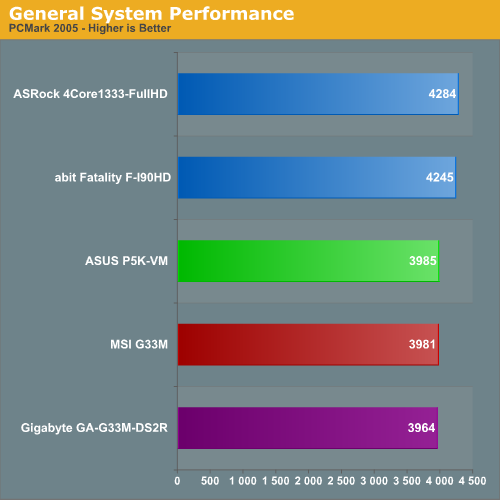
The margins are fairly close in the PCMark05 results with the X1250 platform showing a minor advantage over the G33 platforms due to better video performance results. However, the balance of tests favor the Intel boards. We also noticed after updating to the 15.6 Intel Vista drivers that our scores further dropped when compared to the 15.4 drivers utilized in our last article. This was surprising to us as our GPU benchmarks improved when updating to the latest driver set. While this benchmark is designed around actual application usage, we will see if these results mirror our application testing.
The Office 2003 test from the PC WorldBench 6.0 benchmark test suite features a number of test scripts that simulate general office tasks in Access, PowerPoint, Excel, and Word.
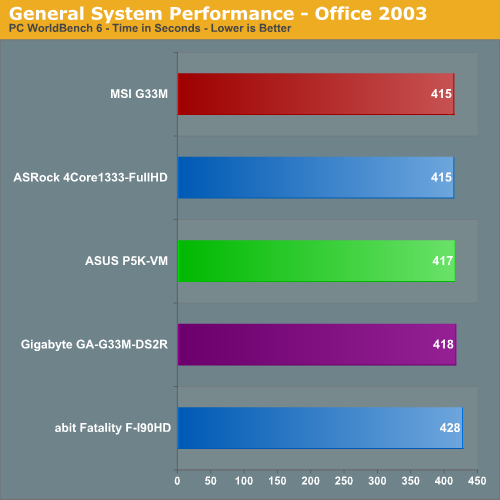
We have a tie between the G33 chipset based MSI board and the X1250 from ASRock. The spread between the group is about 3% so any performance differences are actually very minor.
Media Encoding Performance
We are utilizing an updated video encoding test suite for this article that includes Nero Recode 2, Windows Media Encoder 9, Sony Vegas 7.0e, and Roxio VideoWave 8. The scores reported include the full encoding process and is represented in seconds, with lower numbers providing better performance.
Our first series of tests is quite easy - we take our original Office Space DVD and use AnyDVD to rip the full DVD to the hard drive without compression, thus providing an almost exact duplicate of the DVD. We then fired up Nero Recode 2, selected our Office Space copy on the hard drive, and performed a shrink operation to allow the entire movie along with extras to fit on a single 4.5GB DVD disc. We left all options on their defaults except we checked off the advanced analysis option.
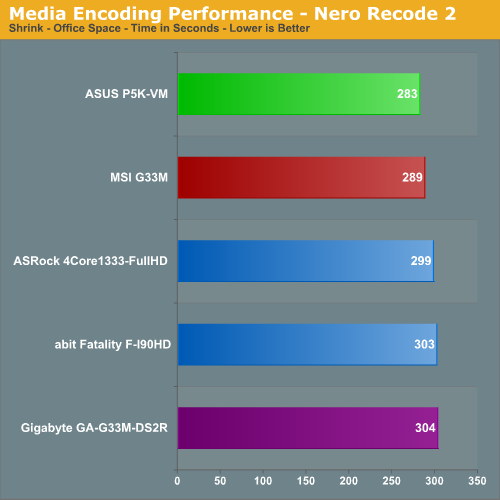
The results are fairly indicative of what we will see in our application testing. The G33 boards will generally fare a little better in CPU or memory sensitive tests due to their latency and memory throughput advantages although our Gigabyte board tends be slightly slower than the other G33 boards when it comes to storage system results. In this test, the ASUS P5K-VM finishes first and is around 7% quicker than the Gigabyte board.
Our next test has us converting our day at the beach AVI file into a high definition WMV file suitable for our Aunt Gertrude to view on her new high definition LCD TV. We ensured our quality settings were set to High Definition. The balance of options is set to standard settings and then we let this program do its magic.
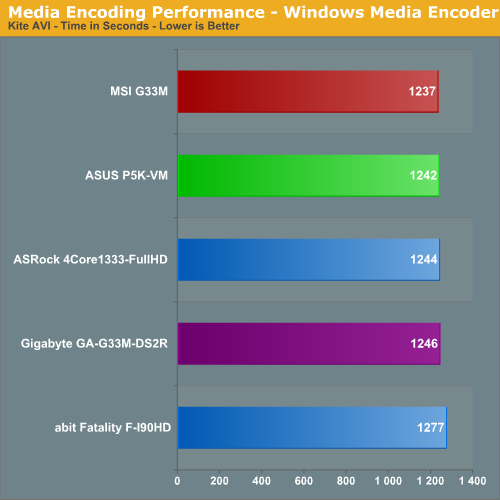
Our MSI board finishes this grueling task first and is 3% quicker than the last place board. While CPU performance is very important in this test, a good storage system is a must during this particular conversion. We see the Gigabyte board finishing behind our other two G33 boards and attribute most of this to the storage system performance not being up to par.
Our Sony Vegas 7.0e test converts several of our summer vacation files into one plasma screen pleasing 1080/24P format with a 5.1 audio stream. We ensured our quality settings were set to their highest levels and then let the horses loose.
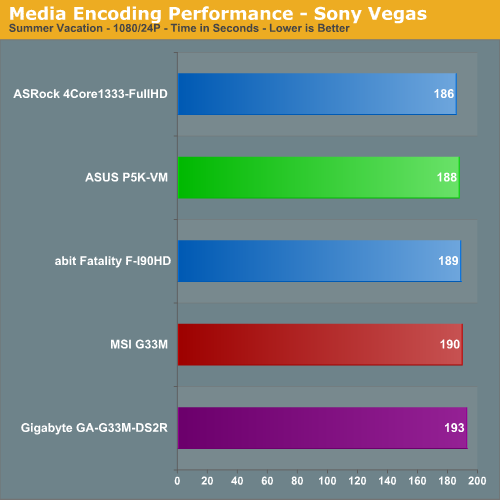
In a test that really stresses the CPU, we see the ASRock X1250 board is about 4% faster than the Gigabyte G33 based board with the ASUS board finishing a couple of seconds faster than the MSI board.
Next on the list is our Roxio VideoWave 8 test from the PC WorldBench 6.0 test suite that does a short contemplation of video vacation shorts into a final movie.
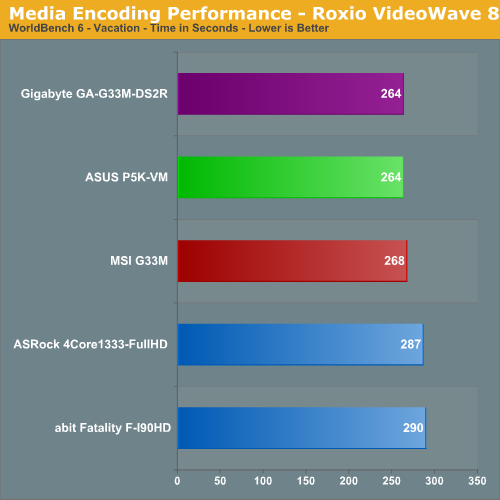
The Gigabyte G33 board finishes first and is about 9% quicker than our X1250 boards in a test that really stresses CPU throughput with less emphasis placed on the storage system. Both X1250 boards make up a second place tier of performance in this benchmark.
Audio Encoding Performance
We will utilize iTunes 7.3 for our audio encoding tests as it is one of the most utilized audio applications available due to the immense popularity of the iPod. We just completed testing with the 7.4.2 release with the results only improving by a percent or two.
Our first task was to figure out what test CD to utilize. We needed one that contained a significant number of tracks and had over 600MB of data in order to properly stress our platforms. After rummaging around the lab and discounting the Burl Ives Greatest Christmas Hits album, we happened upon a CD that would work for our purposes as it was not working for anyone else, INXS Greatest Hits. This one time '80s glory masterpiece contains 16 tracks totaling 606MB of songs that was instantly whisked into our anxiously awaiting optical drive.
Our first test consists of utilizing iTunes to rip our INXS CD in WAV format onto our hard drive. Even though CPU speed and optical drive selection have a great impact on these test results we are using the same optical drive between platforms for each test.
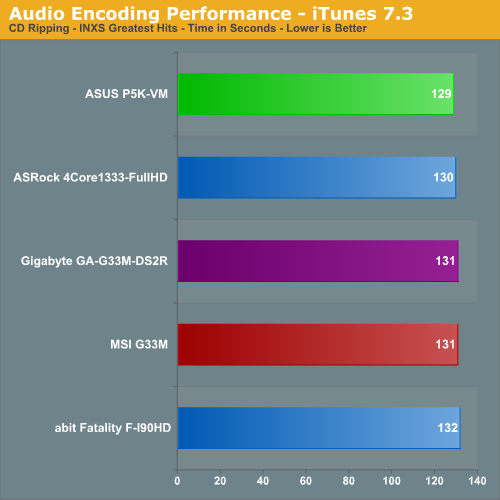
Our test platforms score within 1% of each other. This test was very consistent with each result never varying more than one second from the base score as the test heavily relies on the performance of the optical drive which results in test result margins that are minimal. However, we once again see the ASUS board leading a benchmark that is heavily dependent on the storage system.
Our next two tests have us utilizing iTunes to convert our WAV files into ACC or MP3 compatible formats. We utilize the 320kbps and variable bit rate option for both tests.
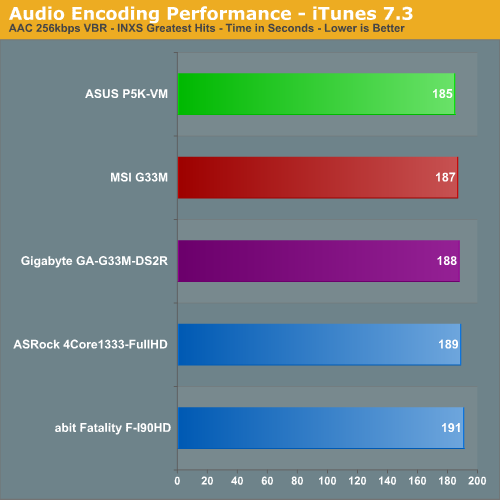

iTunes normally favors a system with excellent CPU throughput and these tests indicate a balance between the Intel G33 and the AMD Radeon X1250 chipsets. The differences between the boards is around 1% in both tests but the ASUS board tops the charts again.
Media Performance
We will take a brief look at general media performance with our test suite that includes Adobe Photoshop CS2 and Adobe Photoshop Elements 5.0.
We utilize the PC WorldBench 6.0 Test for measuring platform performance in Adobe's Photoshop CS2. The benchmark applies an extensive number of filters to the test image and heavily stresses the CPU and storage systems. The scores reported include the full conversion process and is represented in seconds, with lower numbers providing better performance.
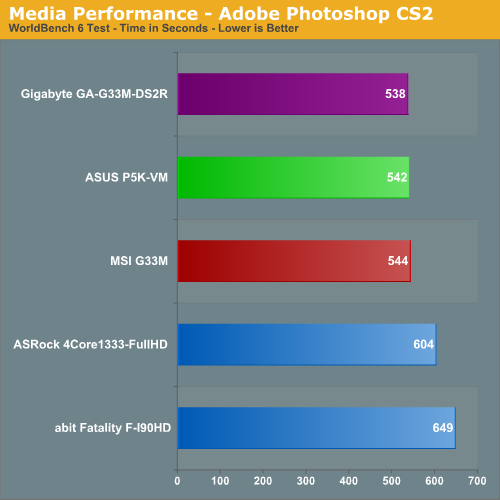
In a surprise, we see the Gigabyte G33 board topping our other two G33 boards - one of the few instances where this occurs. The G33 boards have up to an 18% advantage over the X1250 boards.
Our next test is one recommended by Intel, but the test itself appears to be fair and results are very repeatable. This test simply measures the amount of time required to fix and optimize 103 different photos weighing in at 63MB. Time is measured in seconds, with lower times resulting in better performance:
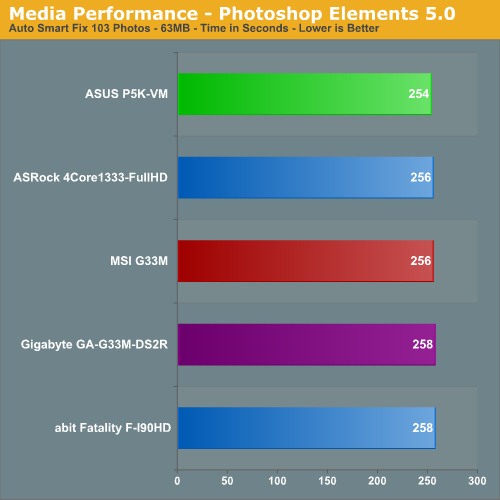
This test heavily stresses the CPU but also requires a quick storage system. Our ASUS P5K-VM tops the chart but only four seconds separates the group.
File Compression Performance
In order to save space on our hard drives and ensure we had another CPU crunching utility, we will be reporting our file compression results with the latest version of WinRAR that fully supports multi-threaded operations and should be of particular interest for those users with dual core or multi-processor systems. Our series of file compression tests utilizes WinRAR 3.62 to compress our test folder that contains 444 files, ten subfolders, and 602MB worth of data. All default settings are utilized in WinRAR along with our hard drive being defragmented before each test.
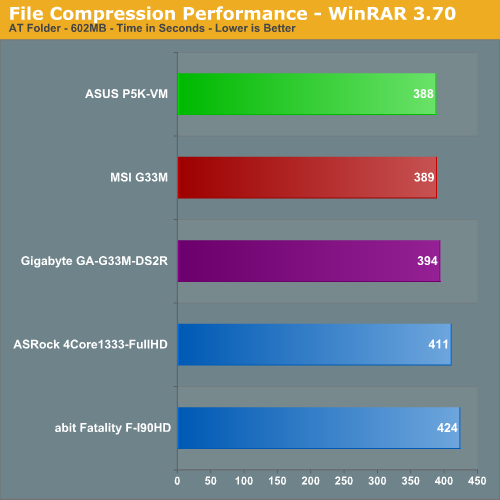
Once again we see the G33 boards perform well in a test that stresses overall memory latencies and CPU/Memory throughput. The nature of file compression is such that memory is accessed almost constantly in a very random fashion, so page misses requiring additional time as memory banks are swapped are common. The ASUS board is 2% quicker than the Gigabyte board and up to 9% faster than the X1250 boards.
Rendering Performance
We are using the Cinebench 10 benchmark as it tends to heavily stress the CPU subsystem while performing graphics modeling and rendering. Cinebench 10 features two different benchmarks with one test utilizing a single core and the second test showcasing the power of multiple cores in rendering the benchmark image. We utilize the standard multiple core benchmark demo and default settings.
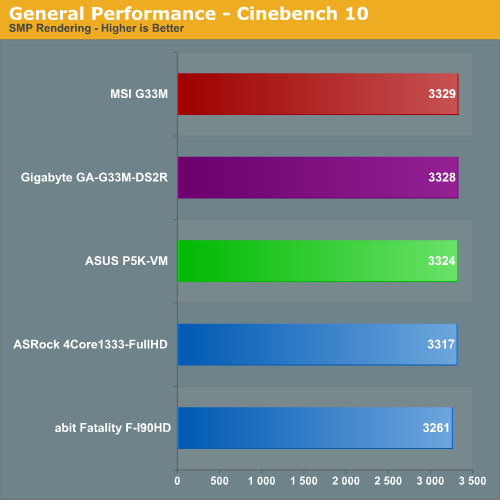
We see the MSI board leading the charts with the ASRock X1250 board nipping on the heels of the G33 boards. Even after a retest with the abit board, the results did not change.
Gaming Performance
As usual, gaming performance was tested with a variety of current games. We ran benchmarks at a 1024x768 resolution. Much more than this resulted in completely unplayable game conditions although we did find several older non-FPS games such as the Civilization series, Railroad Tycoon 3, Rollercoaster Tycoon series, and others played acceptability up to 1280x1024 with the quality settings at normal or lower.
Battlefield 2
This benchmark is performed using DICE's built-in demo playback functionality with additional capture capabilities designed in house. During the benchmark, the camera switches between players and vehicles in order to capture the most action possible. There is a significant amount of smoke, explosions, and vehicle usage as this a very GPU intensive Battlefield 2 benchmark. We run Battlefield 2 using medium quality graphics settings available in the video settings. The game itself is best experienced with average in-game frame rates of 35 and up.
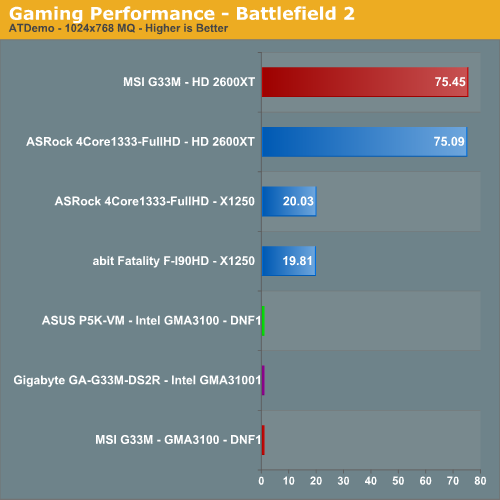
Half Life 2: Episode One
We use the built-in timedemo feature to benchmark the game. Our timedemo consists of starting at the bottom of the hill near the lake and ending in the old church. The Source engine timedemo feature is similar to the nettimedemo of Id's Doom 3 engine, in that it plays back more than just the graphics. The visual quality settings were set to high or medium where possible with HDR off. While the Source engine is notorious for giving great frame rates for almost any hardware setup, we find the game isn't as enjoyable if it isn't running at 30fps or above.
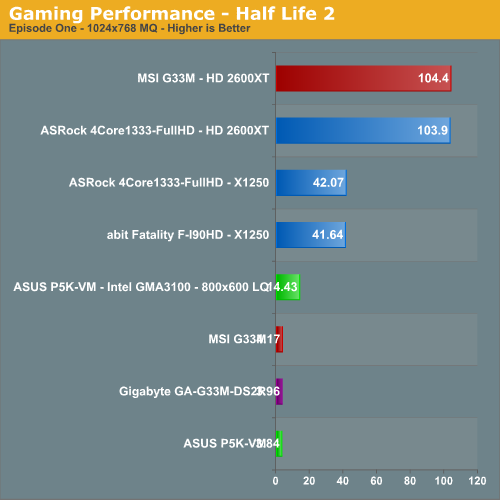
Company of Heroes
Company of Heroes is a GPU intensive game but still requires a well performing CPU at times. The game contains a built-in performance test that utilizes the game engine to generate several different action scenes. We found the performance test gives a good indication of how well your system will perform throughout the game on average. Some of the in-game action sequences are more demanding than the performance test, but we generally found the game to be enjoyable with an average performance test frame rate above 25fps. We set our quality settings to medium or low where applicable except for the first two are set to high and the sliders are set in the middle spot.
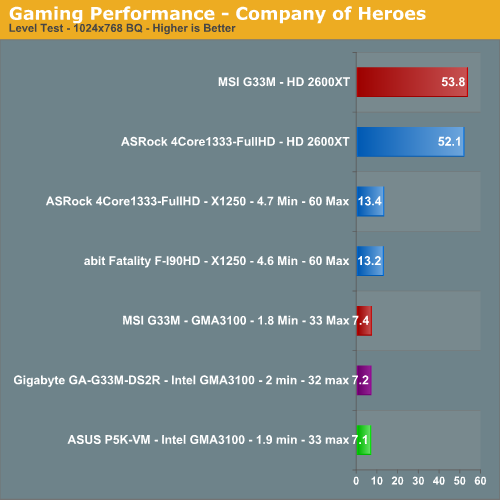
Sims 2
Sims 2 was released over two years ago and is constantly being updated with best selling expansion packs. In testing with the various expansion packs we did not notice any measurable differences in performance so our benchmark will be reflective of game play with the using the base game title. This particular game requires a decent CPU and very good GPU when utilizing the antialiasing, shadow, or high quality texture options.
We once again utilize FRAPS to capture the results from our replay file. Our benchmark consists of a three character scenario that takes approximately twenty minutes to setup and cycle through a series of daily events. The camera movements are varied as is the movement so we feel like this benchmark represents the typical game. We set most video options to high but disables shadows. We generally found the game to be enjoyable with an average frame rate above 30fps.

Supreme Commander
Supreme Commander is one of the favorite real time strategy games around the office as it continues to provide a great deal of replay value and the graphics are very good once the eye candy is turned on, but that will not happen today. What we especially like about the game is the fact that it can bring the best system to its knees and that fact makes it a great system benchmark. This particular game requires both a very good CPU and GPU when playing the game at anything above 1024x768 with decent settings. We utilize the game's built-in benchmark and generally find the game to be enjoyable with an average frame rate above 25fps.
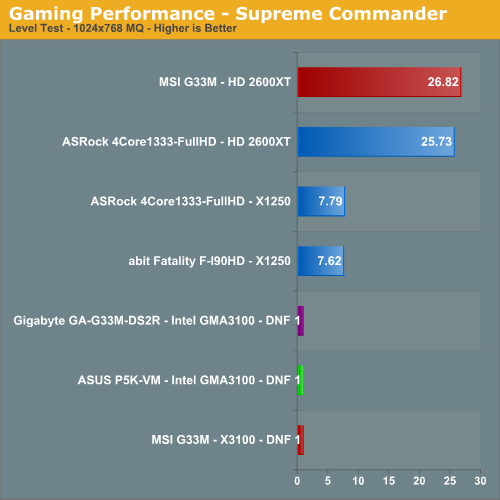
Gaming Summary
The G33 was incapable of running Battlefield 2 and Supreme Commander. Offline testing with Quake 4 and Prey resulted in an interesting slide show that allowed us to see every detail of the benchmark session in a slow, excruciating fashion. Frankly, a visit to the dentist for a root canal almost seems like a better use of time. Not all modern games completely failed to run, however.
G33 was able to generate results (for this grouping) in Company of Heroes and Sims 2. Image quality generally favors the X1250 in most games we tested. The G33 had acceptable image quality but at times we could tell certain details were not as sharp or even evident when compared to the X1250 boards. While most people will not be buying these boards for gaming purposes without an external GPU solution, we did find that reducing the resolutions to 800x600 and slightly increasing the quality settings did result in a passable experience on a temporary basis in games the chipsets would run.
The graphics capabilities of these chipsets in gaming are best left for older RTS type games or DirectX 8 based FPS/RPG titles. Most kid oriented games should also run, provided they don't explicitly check for an NVIDIA or ATI GPU.
Disk Controller Performance
We have utilized the Intel iPeak test for the past few years to measure "pure" hard disk or controller performance on Windows XP. Unfortunately, iPeak is not compatible with Vista so we will utilize two sections of the HDD test suite within PCMark05 for comparative hard disk or controller scores. This particular test suite provides a mixture of actual application results and specific read/write percentages within these programs. It is also a readily available benchmark that others can use for comparative purposes. The program utilizes the RankDisk application within the Intel iPeak SPT suite of tools to record a trace of disk activity during usage of real world applications. These traces are then replayed within PCMark05 to generate performance measurements based upon the actual disk operations within each application. The HDD test suite contains 53% read and 47% write operations with each trace section utilizing varied amounts of read or write operations. Additional information about the test suite can be downloaded in PDF format from this location.
The PCMark05 test results we are utilizing are based upon the following trace runs:
Application Loading: This test consists of 83% reading and 17% writes that tracks the opening and closing of the following programs.
- Microsoft Word
- Adobe Acrobat Reader
- Windows Media Player
- 3Dmark 2001SE
- Leadtek WinFast DVD
- Mozilla Internet Browser
- Opening a Microsoft Word document, performing grammar check, saving and closing
- Compression and decompression using WinZip
- Encrypting and decrypting a file using PowerCrypt
- Scanning files for viruses using F-Secure Antivirus
- Playing an MP3 file with Winamp
- Playing a WAV file with Winamp
- Playing a DivX video using the DivX codec and Windows Media Player
- Playing a WMV video file using Windows Media Player
- Viewing pictures using Windows Picture Viewer
- Browsing the Internet using Microsoft Internet Explorer
- Loading, playing and exiting a game with Tom Clancy's Ghost Recon

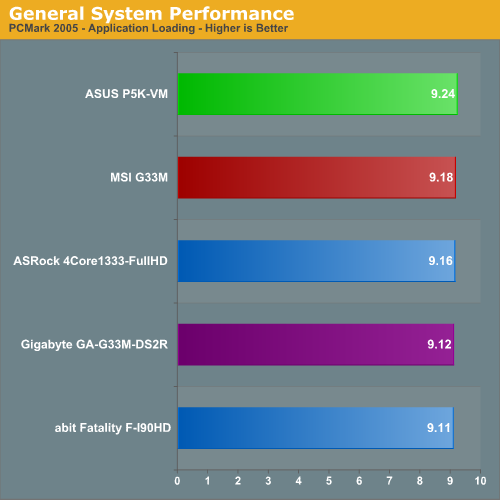

The performance pattern in these tests indicates what we witnessed in actual application testing: in tests that are heavily dependent on the storage system, the Intel ICH9 performs the best. The differences are very minor but the ASUS board offers the best overall disk performance among our test units.
Ethernet Performance
The current motherboard test suite includes LAN performance measurements. All of these boards utilize PCI or PCI Express based controllers with the only difference being the supplier of the core logic.
The Windows 2000 Driver Development Kit (DDK) includes a useful LAN testing utility called NTttcp. We used the NTttcp tool to test Ethernet throughput and the CPU utilization of the various Ethernet Controllers used on the Intel motherboards.
We set up one machine as the server; in this test, an Intel system with an Intel CSA Gigabit LAN connection. Intel CSA has a reputation for providing fast throughput and is a logical choice for our Gigabit LAN server.
On the server side, we used the following Command Line as suggested by the VIA whitepaper on LAN testing:
Ntttcpr -m 4,0,‹server IP› -a 4 -l 256000 -n 30000Ntttcps -m 4,0,‹client IP› -a 4 -l 256000 -n 30000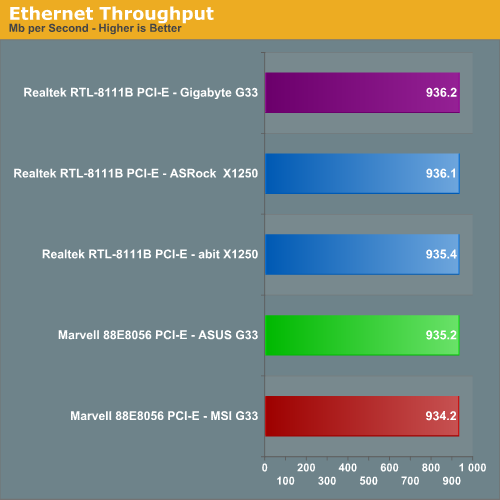
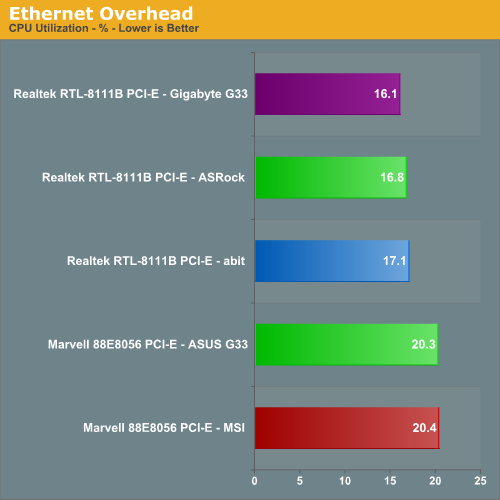
Both the CPU utilization and throughput performance favors the Realtek Gigabit controllers with the Gigabyte implementation offering the best combination. However, the differences are slight and will not be noticed under normal operating circumstances.
Power Consumption
We measured power consumption in three states: at idle sitting at the Vista desktop after 10 minutes of inactivity, and under load while running our Nero Recode 2 and Company of Heroes benchmarks. At each setting, all available power saving options were enabled in the BIOS and operating system to keep power consumption to a minimum, although obviously the biggest difference occurs at idle.

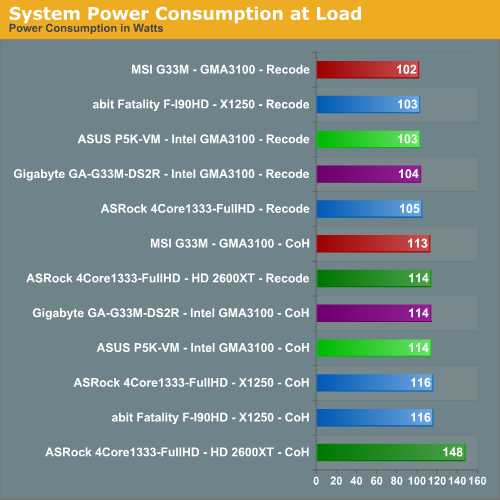
In our previous article, the MSI G33M consumed slightly less power than the X1250 Radeon express platforms but after the latest BIOS update that trend reversed itself. One of the main culprits for this change is the standard CPU voltage switched from 1.200V to 1.300V at idle along with the need to increase DRAM voltage from 1.8V to 1.9V for complete stability. In separate testing the AMD HD 2600XT consumes about 13 additional watts at idle and up to 32 more watts of power under load in Company of Heroes when compared to the onboard video solutions.
Audio Performance
Vista has brought about major changes in the audio stack and as such we will have a dedicated article next month on this subject along with a performance/quality comparison of the latest sound cards. The excellent Rightmark Audio Analyzer is not fully compatible with Vista yet, so objective benchmarks are not available with this tool. We are working with 6.0.6 release now and will have an update shortly. In the meantime, we will only present a single game result today as the general performance, or lack thereof, of the Intel GMA3100 leads us with one current game in our test suite that can be accurately tested.
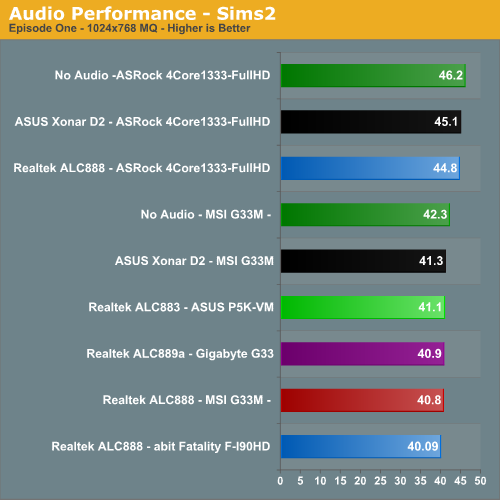
The audio performance numbers remain consistent between the Realtek ALC888 and ASUS Xonar D2 solutions with either the on-board or add in GPU. The CPU utilization rates and effects on our game benchmarks are minimal since 3D audio positioning (DirectSound 3D/EAX 2) is not available under Vista for these host-based audio solutions. This is a positive from a performance viewpoint when considering frame rate hits under XP in such games as Battlefield 2 reflect an average loss of 22%, Half Life 2- Episode One at 6%, and Company of Heroes at 5%.
After comparing the ASUS Xonar D2 to the Realtek offerings in each of our games it was difficult to hear any substantial differences in Half Life Two - Episode One while there was a clear difference in Battlefield 2 and Company of Heroes. Even though 3D audio positioning is not available, the general ambient sounds and especially weapon sounds definitely sounded better on the Xonar D2 with explosions actually having an impact instead of sounding like a nail dropping on a tin roof. For those wondering about results with the Creative X-FI, we will have those in the upcoming audio comparison article as the latest drivers have left us with screeching sounds in BF2 and Company of Heroes.
There was no comparison in our music and video playback tests where the Xonar D2 just annihilated the Realtek ALC888/883 implementation. The Realtek ALC889a offering on the Gigabyte board certainly sounded better than the other Realtek codecs but was still outclassed by the Xonar. This is not surprising and should be expected but during the intense action sequence on the bridge in Mission Impossible III, the Realtek ALC888/883 output during the drone's flyby sequences sounded something like a beached whale when the missiles were fired and then again upon impact. We did make some adjustments with the Realtek control panel and fine tuned our speaker locations/receiver settings which did improve the audio output quality when utilizing the analog connections. These problems were somewhat mitigated when using the S/PDIF output on the ASUS board.
We have to wonder what Gigabyte was thinking by not offering an coaxial or optical output on a board with the Realtek ALC889a considering the improvements over the previous codec families. Overall we suggest buying a decent audio card if you plan on using your computer as a media or gaming station.
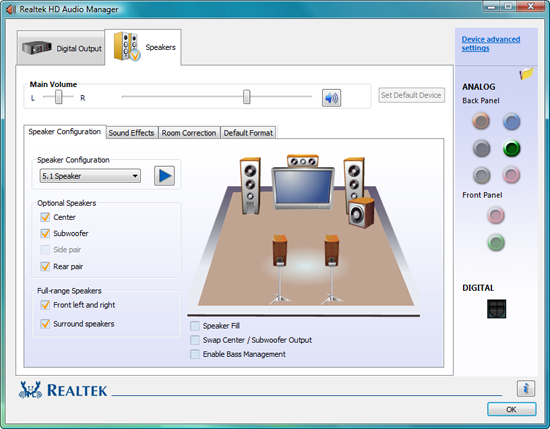
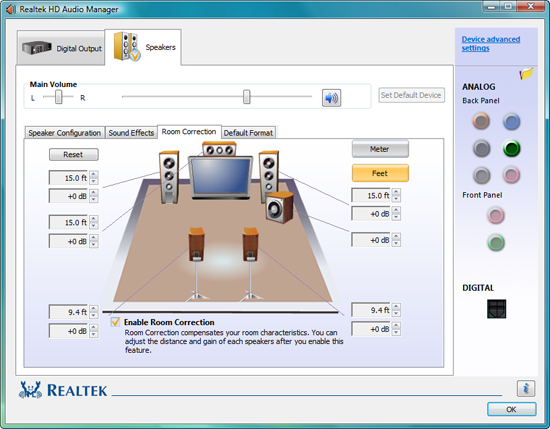
The Vista audio control panel for the Realtek HD codec offers a wide range of options to setup your speakers although a headphone setting and equalizer are not available. For those on a budget, the out of box experience with the Realtek solution is acceptable enough for everyday usage until one can afford a better solution.
Final Words
Considering the IGP market accounts for almost 90% of PC shipments, it's very apparent that boards in this sector must meet a wide variety of goals in order to be successful. If nothing else, they must be the jack of all trades but master of none. The Intel G33 chipset reminds us of that philosophy.
What we basically have in the G33 chipset is a P35 core with a "GMA950+" IGP unit tacked on it. This means the G33 based boards will perform very well in a variety of tasks that do not rely on video processing power. While the video capabilities of the G33 will suffice for running Vista Aero, just about any office application, and a wide variety of non-3D based games, it is not up to the task of running the latest games, decoding 1080P HD content, or even providing decent video capabilities for a media station.
At the same time the video output is limited to analog only unless the motherboard manufacturer adds in a separate SDVO chipset, something most are not willing to do based upon the extra cost. While this output capability may suffice for some, the majority of monitors being sold today for PC use have DVI capability with HDMI quickly gaining traction. All of this is a moot point if you pair the board with one of the latest GPU solutions, but at the same time why should you need to if the competition is already offering HDMI 1.2 output, DVI output, 1080P playback capability, accelerated WMV playback, a superior Aero experience, and even better gaming performance? Okay, not that much better on the last, but enough that most people will notice if casual gaming is important to them.
We are generally disappointed with the video capabilities of the G33 chipset if it is not evident by now; however, we know Intel is addressing the majority of these concerns in the upcoming G35 release that features the new X3500 graphics core. With that said, the general performance of the chipset in applications is very good and with the addition of a dedicated GPU card would make for an excellent SFF platform.
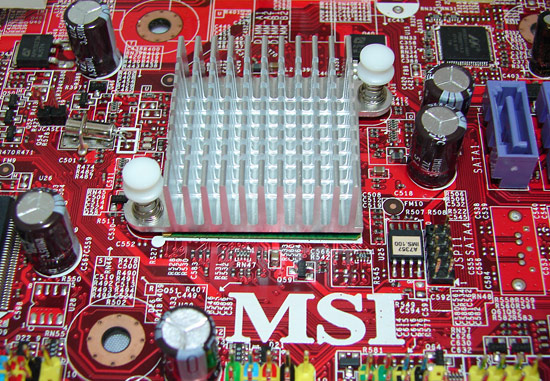
As for the boards based upon the G33 chipset, each one is designed for a different market sector with the ASUS board going after the SOHO crowd, Gigabyte after the SFF gaming crowd, and MSI after the general business or casual home user. They all succeed in some form or fashion in their intended market space, though there are a few surprises.
Overall, we liked the ASUS board best. While it did not excel in every area, it was consistently good in each area. Overall compatibility with a wide variety of components and applications is better than the other two boards. It just seems as if any CPU, memory, video card, auxiliary card, input device, or storage item works well with it. This is not to slight MSI or Gigabyte as their compatibility with peripherals is excellent also, but these other two boards at times require certain BIOS settings or changes to function properly when the same components are plug and play on the ASUS board. The ASUS P5K-VM also offers the best overall performance of our G33 based boards and is certainly the easiest one to work with when overclocking. It is difficult to put into words, but the board simply works as it should -- sadly something that we can't say about some of the other offerings in this market.
If you plan on using one of these boards as a basis for a gaming system or in an SFF system and do not plan on serious overclocking, then the Gigabyte board probably has the best option list available and is the only board to offer RAID via the ICH9R and more than 5 SATA ports. Also, the Realtek ALC889a is an improvement over the ALC888/883 codecs utilized in the other boards. We prefer the general layout of the Gigabyte board and it offers very good stock performance, but it's a disappointment when overclocked compared to the other two boards. We have also grown tired of the Crayola color scheme, Ctrl-F1 "Top Secret BIOS options", and the lack of fan headers on the DS series of boards. That said, the board's use of quality components, support, and overall construction usually has us overlooking the other negatives, but not for too much longer. Then there's the price, which at $15 more than the ASUS and $40 more than the MSI is quite difficult to justify for some in this market sector.
That brings us to the MSI board. It has the lowest price of the group at $92.99 or less, and it's designed for the office crowd. It is the only G33 board to offer eSATA, although it limits the on-board SATA connections to three and still offers Firewire 400. The stock performance is very good and overclocking is excellent with a 1066 or 1333MHZ FSB processor -- provided you have proper CPU cooling as this board will require slightly higher CPU voltages. While this board requires the most effort in getting the BIOS set up properly for overclocking or utilizing 4GB of memory, it does perform very well and is just shy of the ASUS board in overall performance. Considering the price/performance ratio, we would say this board offers a great value in the G33 market sector for those needing above average performance with budget features.
However, these boards don't exist in a vacuum -- there are many other uATX options out there. We really cannot recommend any of these boards for the user who needs a basic HTPC setup and does not want to spend more on the GPU than they spent on the board, processor, and potentially memory in some cases. In the Intel world, the AMD Radeon X1250 offers a significantly better feature set, as do the NVIDIA MCP73 based boards that we will see in our next article. These same video capabilities are also available in the AMD 690G and (to a certain extent) the NVIDIA 7050 boards for AMD. That sometimes is the issue with being a jack of all trades: you get left out in the cold when somebody needs a master tradesman for a specific job.







